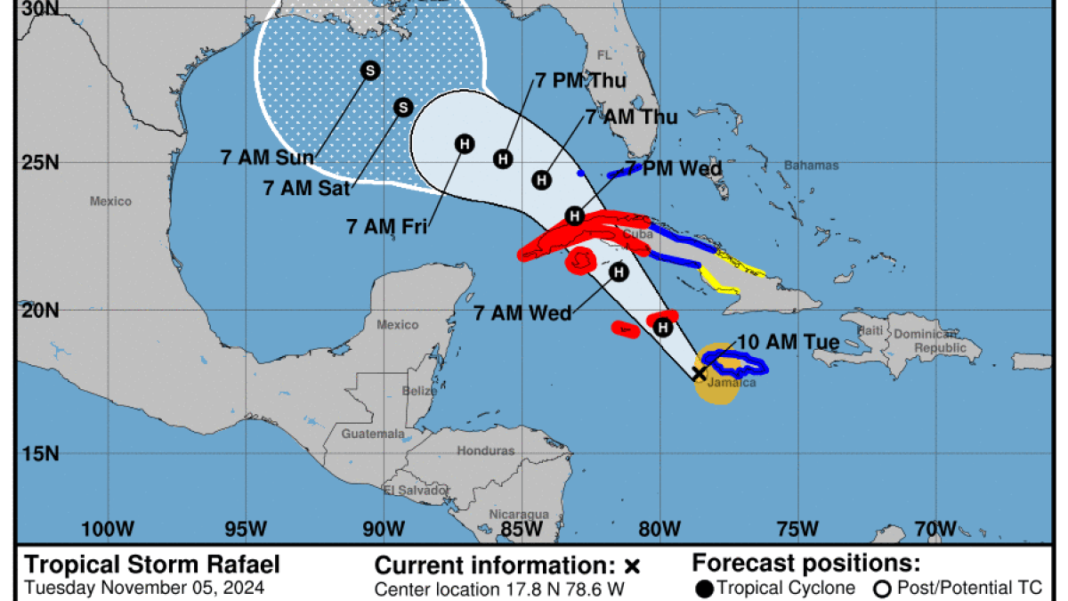Tropical Storm Rafael is set to become a hurricane near the Cayman Islands on Tuesday night before reaching Cuba.
Tropical Storm Rafael is expected to strengthen into a hurricane in the northwestern Caribbean near the Cayman Islands with further strengthening anticipated before it makes landfall in Cuba, the United States National Weather Service reports.
The storm was located 130km (80 miles) south-southwest of Montego Bay, Jamaica, on Tuesday morning. It had maximum sustained winds of 95km/h (60mph) and was moving northwest at 20km/h (13mph), according to the US National Hurricane Center (NHC), located in Miami, Florida.
The storm was passing west of Jamaica on Tuesday morning and was forecast to be near or over the Cayman Islands on Tuesday night before reaching western Cuba on Wednesday.
After Cuba, Rafael’s forecast track will take it into the Gulf of Mexico before running into unfavourable upper atmosphere winds and dry air, curtailing its further development, forecasters say.
Tropical Storm #Rafael Advisory 8: Rafael Getting Better Organized as the Center Passes South Of Western Jamaica. Tropical Storm Warning Issued For the Florida Keys. https://t.co/tW4KeGe9uJ
— National Hurricane Center (@NHC_Atlantic) November 5, 2024
The storm could exacerbate an acute energy crisis in Cuba. Parts of the island have experienced prolonged power outages in recent weeks due to decrepit infrastructure and a lack of fuel for its oil-fired power stations.
The island is still struggling to recover from Hurricane Oscar, which battered the island about two weeks ago after making landfall in the eastern part of Cuba, killing at least six people.
A hurricane warning is in effect for the Cayman Islands and western Cuba, including the tobacco-growing province of Pinar del Rio, as well as the capital, Havana. A tropical storm warning is in effect for Jamaica and central Cuba as well as a large portion of the Florida Keys.
“The storm is currently situated in an atmospheric and oceanic environment that is quite conducive for strengthening,” the NHC said.
Forecasters warned Rafael would unleash heavy rains across the western Caribbean that could lead to flooding and mudslides with totals of 70mm to 150mm (3 to 6 inches) and up to 250mm (10 inches) expected locally in Jamaica and parts of Cuba.
Heavy rainfall also was expected to spread north into Florida and parts of the southeast US during the middle to late part of the week. A few tornadoes also were expected on Wednesday over the Keys and southwesternmost Florida mainland.
‘Remain vigilant’
Officials closed schools and government offices in the Cayman Islands as they urged residents to prepare. Long lines were reported at grocery stores as the storm approached.
Jamaica also closed down as a precaution as the storm’s outer winds battered the island late on Monday.
“We urge all Jamaicans to remain vigilant,” said Minister of Local Government and Community Development Desmond McKenzie.
Cuban authorities said on Monday evening that about 37,000 people are under evacuation orders in far eastern Cuba in the province of Guantanamo.
Rafael is the 17th named storm of the season. A tropical storm forms when sustained winds reach 63km/h (39mph), and it becomes a hurricane when they reach 119km/h (74mph).
Tropical Storm #Rafael has formed in the Caribbean – the 17th named storm of the 2024 Atlantic #hurricane season and 10th to form since 24 September. That’s the most Atlantic named storm formations on record between 24 September – 4 November, breaking old record of 9 set in 1950. pic.twitter.com/ZCnkUrv52O
— Philip Klotzbach (@philklotzbach) November 4, 2024
The National Oceanic and Atmospheric Administration predicted the 2024 hurricane season was likely to be well above average with 17 to 25 named storms. The forecast called for as many as 13 hurricanes and four major hurricanes.
An average Atlantic hurricane season produces 14 named storms, seven of them hurricanes and three major hurricanes.
The hurricane season runs from June 1 to November 30, though storms are less likely to occur in the final month as cooler weather prevails.
Rafael would be the 11th hurricane to form this year, with four becoming major Category 3 storms with maximum sustained winds of 178km/h (111mph) or more.







